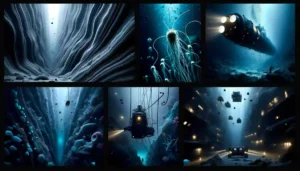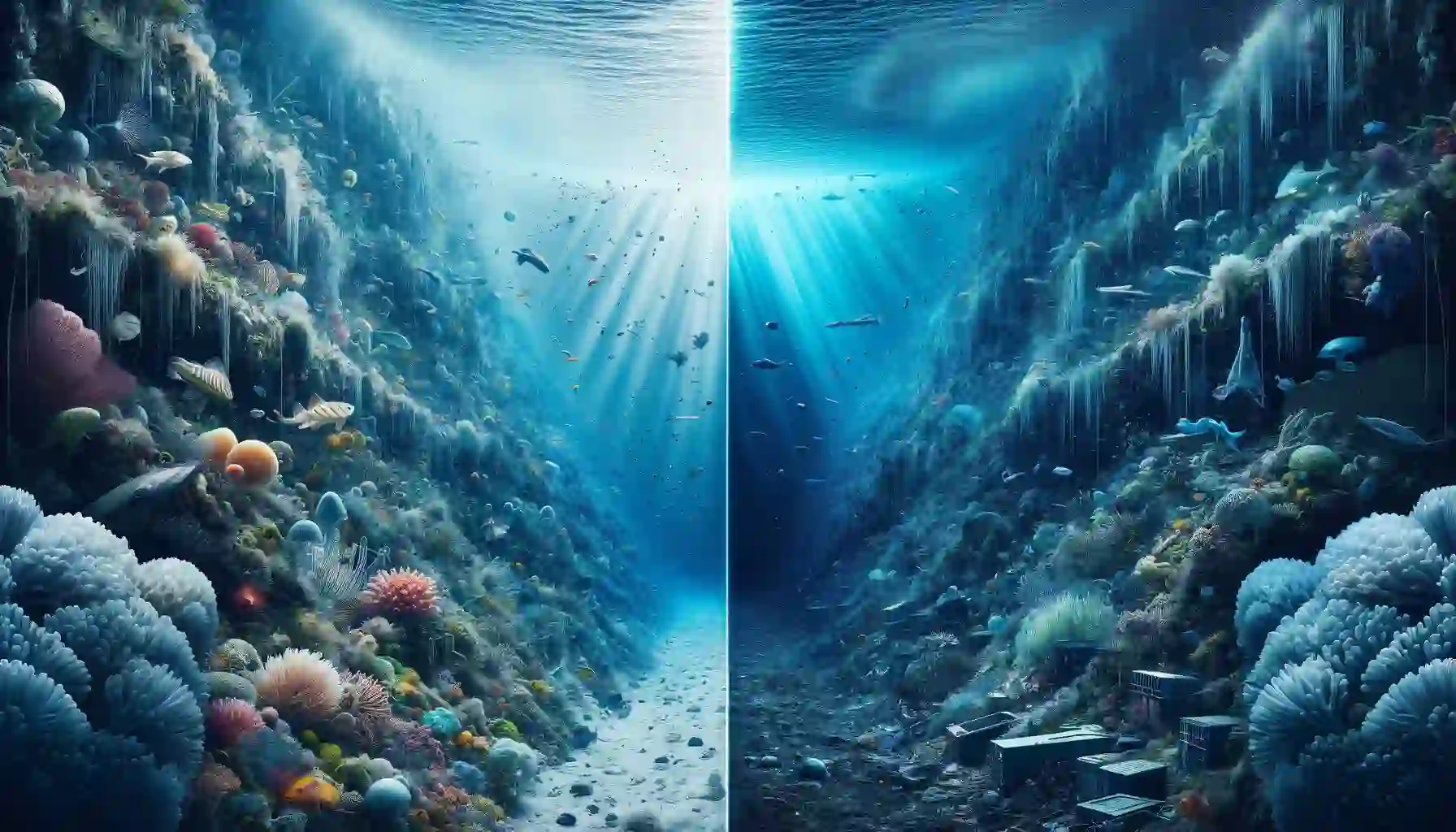Challenger Deep lies at the heart of the ocean’s mysteries. It’s the deepest known point on Earth. This blog takes you on a journey to the bottom of the ocean. We aim to uncover the secrets of Challenger Deep.
Challenger Deep is in the Mariana Trench’s southern end. It reaches depths of over 36,000 feet. Here, darkness prevails, and the pressure is immense. This place challenges our understanding of life. It pushes the boundaries of what’s possible.
Our journey is not just about geography. It’s about human determination and scientific discovery. We will explore life in extreme conditions. We will see how technology helps us reach these depths.
Challenger Deep shows us the unknown parts of our planet. It reminds us of the vast, unexplored spaces. Through this exploration, we hope to inspire curiosity. We want to emphasize the importance of preserving these frontiers.
Unveiling Challenger Deep:

Geological Features: Challenger Deep’s landscape is unique. It has steep walls, floors covered in sediment, and hydrothermal vents. These features tell us about the Earth’s crust. They reveal the forces behind tectonic activity.
History of Discovery and Exploration: Challenger Deep was named after the HMS Challenger. This ship first measured its depth in 1875. The first manned descent was in 1960. Jacques Piccard and Don Walsh piloted the Trieste to the bottom.
Since then, few missions have reached Challenger Deep. Technology has evolved. We now send sophisticated vehicles to explore. These missions provide valuable data. They help us understand the deep ocean.
Exploring Challenger Deep is a story of progress. It started with the HMS Challenger. Now, modern expeditions use advanced technology. Each mission brings us closer to understanding our planet.
Challenger Deep’s Marine Life: Mysteries of the Abyss
Challenger Deep is a world apart, home to extraordinary marine life adapted to its extreme environment. This section explores the remarkable creatures living in the deepest part of the ocean and how they’ve adapted to thrive in such harsh conditions.
The abyssal zone of Challenger Deep is pitch dark, with pressures exceeding 1,000 atmospheres and temperatures near freezing. Yet, it teems with life. The snailfish, for example, can survive here, displaying an astonishing ability to withstand high pressure. These fish have special proteins and cell structures that prevent damage from extreme compression.
Bioluminescent organisms illuminate the darkness of Challenger Deep. Jellyfish, certain squids, and other marine species produce their own light. This adaptation is crucial for attracting prey, mating, and communication in the perpetual night of the deep sea.
Life in Challenger Deep relies on chemosynthesis, a process distinct from photosynthesis. Bacteria convert chemicals from hydrothermal vents into organic matter. This forms the base of the food web, supporting a range of species from tiny microbes to larger predators.
The adaptations observed in Challenger Deep’s marine life are a testament to the resilience and versatility of life. These creatures have evolved unique mechanisms for survival, such as antifreeze proteins and pressure-resistant membranes. Their existence challenges our understanding of life’s boundaries and offers insights into potential life in extraterrestrial oceans.
Understanding the adaptations of Challenger Deep’s inhabitants not only fascinates but also highlights the importance of preserving these deep-sea ecosystems. They are vital for biodiversity and offer clues to the origins and limits of life on Earth.
Challenger Deep: Technological Advances in Abyss Exploration
The quest to explore Challenger Deep has spurred remarkable technological advancements. Submersibles and autonomous underwater vehicles (AUVs) are at the forefront of this exploration. They withstand extreme pressures that crush conventional equipment. These machines are marvels of engineering, equipped to capture the abyss’s unseen world.
Robotic arms, high-definition cameras, and advanced sensors are standard on these vehicles. They gather data and samples from depths unreachable by humans. This technology provides a window into the mysterious ecosystems of Challenger Deep.
Despite these advances, the challenges are immense. The pressure, cold, and darkness of the deep sea test the limits of human ingenuity. Each mission requires meticulous planning and innovation to succeed. Yet, the rewards are unparalleled. Successful expeditions to Challenger Deep offer priceless insights into marine life, geological processes, and the potential for new discoveries.
The exploration of Challenger Deep showcases human determination to uncover the unknown. It highlights the importance of technology in expanding the boundaries of exploration. As we continue to delve into the depths, these technological marvels will lead the way, revealing the secrets of our planet’s final frontier.
Mapping Challenger Deep: Charting the Depths Unseen
Mapping Challenger Deep has significantly advanced our understanding of the ocean’s depths. Importantly, this endeavor serves multiple purposes. Firstly, it aids scientists in studying geological and biological processes deep within the ocean. Additionally, it plays a crucial role in conservation efforts, providing detailed topographical data of the ocean floor. This information is essential for navigating and exploring uncharted territories like Challenger Deep.
Breakthroughs in Mapping Technologies
Remarkably, recent technological advancements have dramatically improved our ability to map the seabed. Multibeam sonar technology stands out as a pivotal tool in this quest. By emitting sound waves and measuring their return time, it creates detailed maps of the ocean floor’s structure and depth. Consequently, this technology has become indispensable for researchers studying deep-sea environments.

Furthermore, autonomous underwater vehicles (AUVs) have revolutionized deep-sea exploration. These vehicles, equipped with cutting-edge sensors, can venture into depths that are otherwise inaccessible to humans. Operating under extreme conditions, AUVs gather critical data from the ocean’s deepest trenches, including Challenger Deep. Thus, they significantly contribute to our growing knowledge of the ocean.
Moreover, satellite imagery complements these underwater explorations. It captures the ocean’s surface to infer the topography below, based on gravitational anomalies caused by massive underwater features. This approach has been instrumental in identifying new aspects of Challenger Deep, broadening our understanding of its complex landscape.
Together, these technologies have opened new pathways for oceanographic research, enabling us to map the deepest parts of the ocean with remarkable precision. Therefore, they are vital for deepening our understanding of the planet’s geology, biology, and environmental challenges. Through such detailed mapping, we pave the way for protecting deep-sea ecosystems, ensuring their preservation for future exploration and study.
Environmental Impact:
The exploration of Challenger Deep unveils a pressing concern: the environmental impact of human activities on its pristine ecosystems. Despite its remote location, Challenger Deep is not immune to the far-reaching effects of pollution, climate change, and deep-sea mining activities. These interventions pose significant risks to the delicate balance of life in the abyss, where ecosystems operate under fine-tuned ecological dynamics.
Firstly, pollution, particularly plastic waste and chemical runoffs, finds its way into the deepest parts of the ocean, affecting marine species in ways we are only beginning to understand. Microplastics, for example, have been detected in organisms residing in Challenger Deep, indicating the pervasive nature of human impact. Moreover, the increasing interest in deep-sea mining for precious minerals threatens to disrupt the sediment and life forms that have existed undisturbed for millennia.
Secondly, the effects of climate change extend into the ocean’s depths, altering temperature and chemical balances. These changes can have unforeseen consequences on deep-sea creatures adapted to stable conditions. Acidification and rising temperatures could shift the delicate equilibrium of Challenger Deep’s ecosystem, posing threats to its biodiversity.
However, there is a growing recognition of the need for conservation efforts. Protecting these unique ecosystems requires international cooperation and stringent regulations on deep-sea activities. Moreover, enhancing our understanding of Challenger Deep through careful and respectful exploration can inform better conservation strategies. By mapping the unseen and studying the unknown, we can advocate for the preservation of deep-sea environments against the backdrop of human advancement.
The path forward involves balancing the curiosity that drives us to explore with the responsibility to protect. As stewards of the planet, the challenge lies in ensuring that the mysteries of Challenger Deep, and the deep sea at large, are preserved for future generations to discover, study, and admire.
The Future of Deep-Sea Exploration:
The future of deep-sea exploration in Challenger Deep and beyond is poised at the brink of a new era. With technological advancements and increased interest in the Earth’s final frontiers, we are on the cusp of uncovering secrets that have lain hidden for millennia. This section looks forward to the ongoing and future projects aimed at exploring these profound depths and the potential scientific breakthroughs they promise.
Ongoing and Future Projects
Currently, exploration projects are harnessing more sophisticated technologies than ever before. Unmanned vehicles equipped with high-resolution cameras and sensors are being deployed to map and study the Challenger Deep with unprecedented detail. Furthermore, international collaborations are increasing, pooling resources and expertise to push the boundaries of what’s possible in deep-sea exploration. These efforts are not only focused on mapping and observation but also on collecting samples that can provide insights into the geology, biology, and chemistry of these uncharted waters.
Moreover, initiatives like the Deep Ocean Observing Strategy aim to establish a long-term presence in the deep sea. By setting up monitoring stations, scientists hope to study the abyssal environment in real-time, observing the effects of climate change and human activity on these remote ecosystems.
Potential Discoveries
The continued exploration of Challenger Deep holds the promise of remarkable scientific discoveries. We anticipate finding new species that challenge our understanding of life and survival under extreme conditions. Additionally, studying these organisms can lead to breakthroughs in medicine and biotechnology, as their unique adaptations could inspire new materials, drugs, and treatments.
Equally important, deep-sea exploration offers insights into Earth’s past. Sediments at the bottom of Challenger Deep can reveal information about the planet’s climate history, helping scientists model future changes. As we delve deeper, we also enhance our understanding of Earth’s geological processes, potentially improving our ability to predict natural disasters like earthquakes and tsunamis.
The future of deep-sea exploration is bright with the potential for groundbreaking discoveries that extend far beyond our current understanding. As we venture further into the abyss, we carry with us the hope of unlocking the mysteries of Challenger Deep, thereby enriching our knowledge of the planet we call home. The journey ahead is not just about reaching the deepest points on Earth but about expanding the horizons of human curiosity and scientific inquiry.
Conclusion:
In concluding our journey into the depths of Challenger Deep, we reflect on the remarkable exploration of this enigmatic trench. Delving into Challenger Deep has not only expanded our understanding of Earth’s most hidden recesses but also highlighted the resilience of life and the ingenuity of human technology. This exploration serves as a poignant reminder of our planet’s vast uncharted territories, urging us to continue pushing the boundaries of discovery and knowledge.
Firstly, the journey into Challenger Deep underscores the profound mystery and allure of the deep sea. It reminds us that, despite our advancements, vast expanses of our own planet remain unexplored, harboring secrets awaiting discovery. The unique ecosystems and remarkable adaptations of marine life in these extreme conditions challenge our perceptions, offering invaluable insights into the resilience and diversity of life.
Also Read: NC Education Lottery: Empowering Education in North Carolina
Moreover, the technological feats achieved in exploring such depths underscore humanity’s relentless pursuit of knowledge. Each mission into Challenger Deep leverages cutting-edge technology, reflecting our growing capability to explore further and deeper than ever before. These endeavors not only advance our scientific understanding but also inspire future generations to continue the exploration of the unknown.
Furthermore, our expedition into the abyss emphasizes the urgent need for conservation. As we uncover the mysteries of Challenger Deep, we are reminded of the delicate balance that exists in these remote ecosystems. It is imperative that our curiosity and quest for knowledge are matched with a commitment to preserving these untouched frontiers.
In conclusion, the exploration of Challenger Deep represents a convergence of curiosity, resilience, and stewardship. It beckons us to marvel at the mysteries of the deep, challenges us to extend the limits of human ingenuity, and calls for the vigilant protection of our planet’s final frontiers. As we stand on the brink of new discoveries, let us move forward with a renewed sense of wonder, responsibility, and determination, ever mindful of the legacy we leave for those who will follow in our path of exploration.








